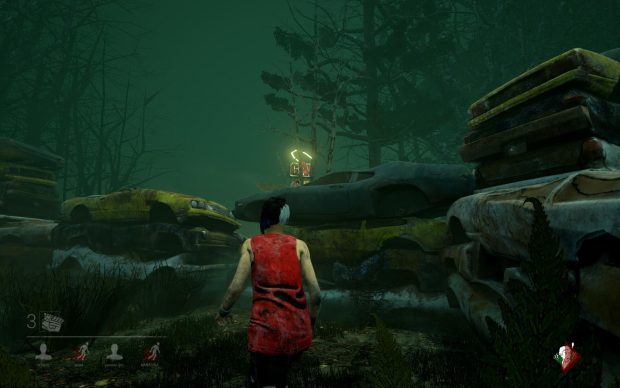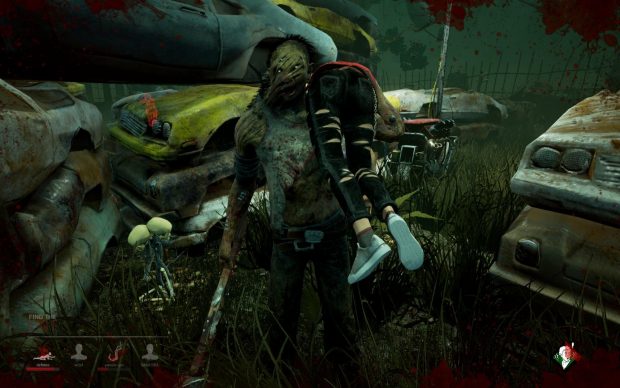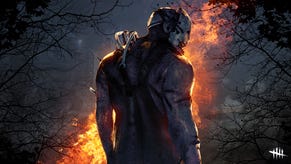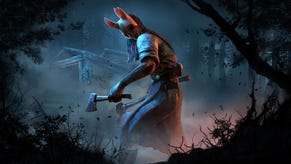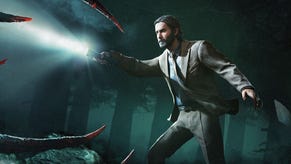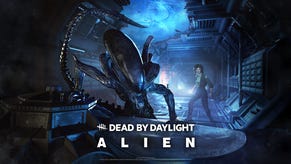Has Dead by Daylight been improved by its updates?
Update Night
Update Night is a new fortnightly column in which Rich McCormick revisits games to find out whether they've been changed for better or worse.
I’m starting to sympathise with Freddy Krueger. Here I am — a monstrous serial killer, armed with unheimlich powers and a wickedly sharp axe — and I’m being given the run-around by a gaggle of teens and twerps in dirty T-shirts. Why won’t they stay still? Why do they keep hiding? All I want to do is chase them down, beat them around the skull, and then heft them onto a rusted meat hook as an offering to the evil god that compels me to kill.
I’m playing Dead by Daylight as the Huntress: a bunny-masked murderer with a set of hatchets and an ooky habit of humming to herself. She’s one of the game’s newest killers, introduced last month in DLC released on the game’s first anniversary, and joins a collection of new characters that have kept the already enjoyable Dead by Daylight from spoiling over time.
Also released in the same package was David King, a new Mancunian survivor who — like all people from his fair city — can handle himself in a fight. King’s against me in this game. He’s one of four player-controlled survivors trying to activate five generators on a procedurally generated stage, dismantling totems and causing distractions along the way so they can power up an exit door and make it out of this horror movie scenario. My goal is simpler: kill them all.
But, by the Antichrist, they’re not making it easy. King’s class perks work to make him tougher than most of his peers, and he uses his abilities well, running interference while his flimsier colleagues get to work repairing generators. He keeps himself in my eyeline and acts as a tempting target. When I do give in and start the chase, he uses his “Dead Hard” perk: an ability that grants him damage resistance and a burst of speed. It takes him out of my axe-swing radius, and gives him the time he needs to pull down a pallet, making an impromptu barricade and blocking my path.
If survivors can time those pallet pulls perfectly, they can stun the killers for a moment, buying them valuable time to get away. Ledges also serve as delaying tactics: where survivors can spring athletically over small walls, killers have to step slowly over them, forcing a slightly longer animation that offers time for escape. Both are frustrating for the chaser, but the most effective weapon for the survivors I was hunting was my own disorientation. Most of Dead by Daylight’s weapons have surprisingly small swing radiuses, meaning you have to be right up on a survivor to connect your rusted metal with their fleshy bits.
Swing and miss and most killers need a moment to recover. Survivors — shorter, sneakier, squirrely types — can use those moments to their advantage while I’m stuck waving my axe in mid-air. I’m meant to feel supernatural, but I end up feeling naturally stupid, butting up against Dead by Daylight’s main frustration: restrictive controls that can make ferocious killers feel feeble in the hands of inexperienced players.
It is, at least, thematically correct. Michael Myers, Jason Voorhees, and their ilk aren’t actually very good at murdering people, spending ages stalking teens but not much time actually offing them. But a bit of time spent in the Huntress’ mouldy dress and I realise she has another trick up her tattered sleeves. In addition to her swinging axe, she also packs a suite of hurling hatchets, readied and chucked by holding the right mouse button.
And so, after a few games familiarising myself with her chase-heavy playstyle, I came up against another altruistic David King player. He, like the last person, was keen to pull me away from the all-important generators, leading me on lengthy chases. As we capered down a hallway, I pulled up one of my hatchets and lobbed it full-strength into his back.
It hit with a thunk, and he screamed. Panicking, he veered off, heading toward a pallet he planned to yank into my path. Spotting the obvious trap, I sidestepped, ducked into an anteroom, and came up alongside him, burying my bigger axe in his neck as he pulled the pallet onto no-one. I picked him off the floor where he lay, prostrate and bleeding, and left him dangling from a meat hook — a grisly signifier that I’d started to get to grips with the Huntress’ play style.
Dead by Daylight’s killers have all seem to have shambled straight off the silver and small screens (particularly so in the case of Halloween’s Michael Myers, introduced last year in DLC as “The Shape”). They all have the same MO, too — namely, bash people around the head and sacrifice them to “The Entity” — but there’s real difference in their play styles. The Huntress, as I learned, was a chase specialist, but the Hag plays a much more psychological game, scrawling hexes on the ground to leap out of the earth and frighten the shit out of players.
The Doctor, another new boy, is my favourite. He’s not so hot at chasing people, but can ferret them out from their hiding spots with ease, thanks to an always-on aura ability that drives survivors mad with fear. To amplify that madness he can switch from “Punishment” mode to “Treatment,” allowing him to jolt survivors with a blast of electricity, ratcheting up their psychological trauma to the point that they start seeing visual manifestations of the Doctor at regular intervals.
As the Doctor, I’d scoot around the map, lingering near generators and listening for tell-tale screams. Rather than go straight for the brain-bash, I started teasing survivors, chasing them and tasing them until they were yelping, gibbering messes, unable to perform the tasks they needed to escape the level. I still didn’t find the hand-to-skull combat hugely satisfying, but as the Doctor, I didn’t need to swing for the fences. In my proudest game, I forced three players to quit just by keeping their madness gauges full for most of the match, standing over them like the world’s most menacing parent as they tried and failed to repair the level’s generators.
Developers Behavior Interactive have made strides to balance the eternal conflict between killers and killees in recent months, adding a new bloodlust system that makes it easier for murderers to catch survivors during lengthy chases. It works, too, cutting down on the kind of Benny Hill chases that allowed survivors to kite killers like kittens chasing laser pointers earlier in the game’s lifespan. Behavior Interactive have also kept an impressive pace with their DLC packs, also releasing new survivors alongside their killers. King, as mentioned, is a pseudo-tank designed to rescue teammates, while esports pro Feng Min is better played as a lone wolf. She’s lithe — as evidenced by her “Lithe” perk — and so gets a speed boost when she vaults over obstacles. Her generator repairs are quieter, too, and she can eventually use her preternatural alertness to spot the killer whenever they bust through obstacles.
Dead by Daylight wears its horror movie influences proudly, and fittingly, each match turns into a little filmic vignette. The survivors are misfits, forced into a shadow world of horrible scenarios in which they have to band together to save the day. And as Adam found out when he lost a weekend to Dead by Daylight last month, the game boasts a surprisingly helpful community, paradoxically strengthened by the lack of voice communication, and assisted by core game mechanics that actively reward supporting your fellow survivors.
Running interference against killers, pitching in to repair generators, and rescuing fellow survivors from hooks aren’t just altruistic actions: they also earn you points that can then be spent levelling up your own characters. Even being the worst survivor you can be and getting yourself hung up like a bloody bauble early in the game can be beneficial to your squad, buying them time to rev up a set of generators.
Players work together with very similar skillsets. There’s less difference between the abilities of King, Min, and the other survivors than there is between the killers, and what differences can be found only really start to show once players have sunk significant time into the game — when they’ve put enough points into the tech tree-esque “bloodweb” to unlock a set of perks. Various perks can be combined with single-use consumables that grant boosts to attacks, allow players to read minds, or hand survivors torches with which to stun the roaming killer.
All of these are earned through play and play alone: there’s no real-world money changing hands here for in-game currency. The system means that longtime players are generally just better than noobs, armed with a set of skills that the latter will need to grind to get. But thanks to the game’s focus on co-operative play, and the very situational boosts the perks provide, even as a level-one character Dead by Daylight is a thrill. I put in consecutive hours of matches over the past few weeks, riding the adrenaline spikes injected by the knowledge that a masked lunatic was on my tail.
I got tired of that, eventually, the panic of a chase slowly replaced by a dull dread as the killer stunned me for the third, fourth, fifth time. But when that happened, and I wanted to turn the tables, I could just pull on my human-skin mask and play the other side of the power fantasy. In its current state, Dead by Daylight is two horror games for the price of one: both speckled with minor frustrations, but both regularly as tense, tight, and scary as a really good horror flick, and with more variety than you would expect from a genre picture.


